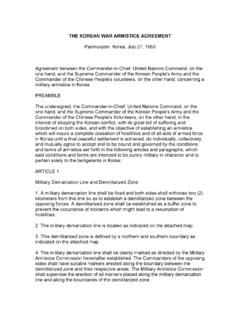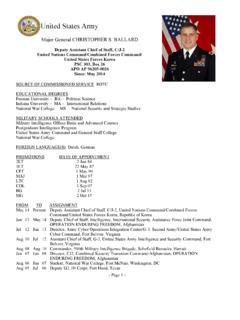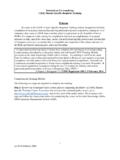Transcription of Panmunjom, Korea, July 27, 1953
1 THE KOREAN WAR armistice agreement panmunjom , korea , july 27, 1953 agreement between the Commander-in-Chief, United Nations Command, on the one hand, and the Supreme Commander of the Korean People's Army and the Commander of the Chinese People's volunteers, on the other hand, concerning a military armistice in korea . PREAMBLE The undersigned, the Commander-in-Chief, United Nations Command, on the one hand, and the Supreme Commander of the Korean People's Army and the Commander of the Chinese People's Volunteers, on the other hand, in the interest of stopping the Korean conflict, with its great toil of suffering and bloodshed on both sides, and with the objective of establishing an armistice which will insure a complete cessation of hostilities and of all acts of armed force in korea until a final peaceful settlement is achieved, do individually, collectively, and mutually agree to accept and to be bound and governed by the conditions and terms of armistice set forth in the following articles and paragraphs.
2 Which said conditions and terms are intended to be purely military in character and to pertain solely to the belligerents in korea : ARTICLE 1 Military Demarcation Line and Demilitarized Zone 1. A military demarcation line shall be fixed and both sides shall withdraw two (2) kilometers from this line so as to establish a demilitarized zone between the opposing forces. A demilitarized zone shall be established as a buffer zone to prevent the occurrence of incidents which might lead to a resumption of hostilities. 2. The military demarcation line is located as indicated on the attached map. 3. This demilitarized zone is defined by a northern and southern boundary as indicated on the attached map. 4. The military demarcation line shall be plainly marked as directed by the Military armistice Commission hereinafter established.
3 The Commanders of the opposing sides shall have suitable markers erected along the boundary between the demilitarized zone and their respective areas. The Military armistice Commission shall supervise the erection of all markers placed along the military demarcation line and along the boundaries of the demilitarized zone. 5. The waters of the Han River Estuary shall be open to civil shipping of both sides wherever one bank is controlled by one side and the other bank is controlled by the other side. The Military armistice Commission shall prescribe rules for the shipping in that part of the Han River Estuary indicated on the attached map. Civil shipping of each side shall have unrestricted access to the land under the military control of that side. 6. Neither side shall execute any hostile act within, from, or against the demilitarized zone.
4 7. No person, military or civilian, shall be permitted to cross the military demarcation line unless specifically authorized to do so by the Military armistice Commission. 8. No, person military of civilian, in the demilitarized zone shall be permitted to enter the territory under the military control of either side unless specifically authorized to do so by the Commander into whose territory entry is sought. 9. No person, military or civilian, shall be permitted to enter the demilitarized zone except persons concerned with the conduct of civil administration and relief and persons specifically authorized to enter by the Military armistice Commission. 10. Civil administration and relief in that part of the demilitarized zone which is south of the military of the military demarcation line shall be the responsibility of the Commander-in-Chief, United Nations Command; and civil administration and relief in that part of the demilitarized zone which is north of the military demarcation line shall be the joint responsibility of the Supreme Commander of the Korean People's Army and the Commander of the Chinese People's volunteers.
5 The number of persons, military or civilian, from each side who are permitted to enter the demilitarized zone for the conduct of civil administration and relief shall be as determined by the respective Commanders, but in no case shall the total number authorized by either side exceed one thousand (1,000) persons at any one time. The number of civil police and the arms to be carried by them shall be a prescribed by the Military armistice Commission. Other personnel shall not carry arms unless specifically authorized to do so by the Military armistice Commission. 11. Nothing contained in this article shall be construed to prevent the complete freedom of movement to, from, and within the demilitarized zone by the Military armistice Commission, its assistants, its Joint Observer Teams with their assistants, the Neutral Nations Supervisory Commission hereinafter established, its assistants, its Neutral Nations Inspection teams with their assistants, and of any other persons, materials, and equipment specifically authorized to enter the demilitarized zone by the Military armistice Commission.
6 Convenience of movement shall be permitted through the territory under the military control of either side over any route necessary to move between points within the demilitarized zone where such points are not connected by roads lying completely within the demilitarized zone. ARTICLE II Concrete Arrangements for Cease-Fire and armistice A. General 12. The Commanders of the opposing sides shall order and enforce a complete cessation of all hostilities in korea by all armed forces under their control, including all units and personnel of the ground, naval, and air forces, effective twelve (12) hours after this armistice agreement is signed. (See paragraph 63 hereof for effective date and hour of the remaining provisions of this armistice agreement .)/ 13. In order to insure the stability of the military armistice so as to facilitate the attainment of a peaceful settlement through the holding by both sides of a political conference of a higher level, the Commanders of the opposing sides shall: (a) Within seventy-two (72) hours after this armistice agreement becomes effective, withdraw all of their military forces, supplies, and equipment from the demilitarized zone except as otherwise provided herein.
7 Al demolitions, minefields, wire entanglements, and other hazards to the safe movement of personnel of the Military armistice Commission or its Joint Observer Teams, known to exist within the demilitarized zone after the withdrawal of military forces therefrom, together with lanes known to be free of all such hazards, shall be reported to the MAC by the Commander of the side whose forces emplaced such hazards. Subsequently, additional safe lanes shall be cleared; and eventually, within forty-five (45) days after the termination of the seventy-two (72) hour period, all such hazards shall be removed from the demilitarized zone as directed by the under the supervision of the MAC. At the termination of the seventy-two (72) hour period, except for unarmed troops authorized forty-five (54) day period to complete salvage operations under MAC and agreed to by the MAC and agreed to by the Commanders of the opposing sides, and personnel authorized under paragraphs 10 and 11 hereof, no personnel of either side shall be permitted to enter the demilitarized zone.
8 (b) Within ten (10) days after this armistice agreement becomes effective, withdraw all of their military forces, supplies, and equipment from the rear and the coastal islands and waters of korea of the other side. If such military forces are not withdrawn within the stated time limit, and there is no mutually agreed and valid reason for the delay, the other side shall have the right to take any action which it deems necessary for the maintenance of security and order. The term "coastal islands", as used above, refers to those islands, which, though occupied by one side at the time when this armistice agreement becomes effective, were controlled by the other side on 24 June 1950; provided, however, that all the islands lying to the north and west of the provincial boundary line between HWANGHAE-DO and KYONGGI-DO shall be under the military control of the Supreme Commander of the Korean People's Army and the Commander of the Chinese People's volunteers, except the island groups of PAENGYONG-DO (37 58' N, 124 40' E), TAECHONG-DO (37 50' N, 124 42' E), SOCHONG-DO (37 46' N, 124 46' E), YONPYONG-DO (37 38' N, 125 40' E), and U-DO (37 36'N, 125 58' E), which shall remain under the military control of the Commander-in-Chief, United Nations Command.
9 All the island on the west coast of korea lying south of the above-mentioned boundary line shall remain under the military control of the Commander-in-Chief, United Nations Command. (See Map 3). (c) Cease the introduction into korea of Reinforcing military personnel; provided, however, that the rotation of units and personnel, the arrival in korea of personnel on a temporary duty basis, and the return to korea of personnel after short periods of leave or temporary duty outside of korea shall be permitted within the scope prescribed below: "Rotation" is defined as the replacement of units or personnel by other units or personnel who re commencing a tour of duty in korea . Rotation personnel shall be introduced into and evacuated from korea only through the ports of entry enumerated in Paragraph 43 hereof.
10 Rotation shall be conducted on a man-for-man basis; provided, however, that no more than thirty-five thousand (35,000) persons in the military service shall be admitted into korea by either side in any calendar month under the rotation policy. No military personnel of either side shall be introduced into korea if the introduction of such personnel will cause the aggregate of the military personnel of that side admitted into korea since the effective date of this armistice agreement to exceed the cumulative total of the military personnel of that side who have departed from korea since that date. Reports concerning arrivals in and departures from korea of military personnel shall be made daily to the Military armistice Commission and the Neutral Nations Supervisory Commission; such reports shall include places of arrival and departure and the number of persons arriving at or departing from each such place.







